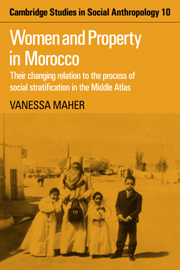 Women and Property in Morocco
Women and Property in Morocco Book contents
- Frontmatter
- Contents
- List of tables
- List of illustrations
- Preface
- Note on orthography
- Map of the Akhdar region
- Introduction
- 1 The background
- 2 Estates, tribal groups and the market today
- 3 Patron-client relations
- 4 How it looks on the ground
- 5 The cultural corollary: education and social stratification
- 6 Religion and social stratification
- 7 Conjugal roles, kinship roles and the division of labour
- 8 Relationships among women
- 9 Fostering
- 10 Marriage
- 11 Marriage and the market
- 12 The position of the bride after marriage
- 13 Divorce and property
- Conclusions
- Glossary
- Select bibliography
- Index
- Frontmatter
- Contents
- List of tables
- List of illustrations
- Preface
- Note on orthography
- Map of the Akhdar region
- Introduction
- 1 The background
- 2 Estates, tribal groups and the market today
- 3 Patron-client relations
- 4 How it looks on the ground
- 5 The cultural corollary: education and social stratification
- 6 Religion and social stratification
- 7 Conjugal roles, kinship roles and the division of labour
- 8 Relationships among women
- 9 Fostering
- 10 Marriage
- 11 Marriage and the market
- 12 The position of the bride after marriage
- 13 Divorce and property
- Conclusions
- Glossary
- Select bibliography
- Index
Summary
In a country in which the majority of the population cannot be assured of long-term employment, it may be expected that the market will not serve as the only vehicle of exchange and distribution. In the Middle Atlas of Morocco where this study was carried out, conditions of high unemployment obtain. Further, women do not work for wages because their participation in the ‘public sphere’ is considered immoral. Thus, some members of the population can sell their labour in the market; to the majority, this option is not available (see Table 2).
These two sets of circumstances give rise to two different modes of social relationship. The one is characterised by some of the traits which Weber associated with the rise of Western capitalism, and indeed, has become more widespread with the intensification of economic and cultural exchanges with Western Europe (particularly France) since the beginning of the twentieth century, and with the United States since the war. The belief in the legitimacy of working for gain, and of accumulation, the belief that the individual is his own best patron, and a diminished dependence on ascriptively recruited groups for economic and political support – such traits are typical of this outlook.
The other mode of relationship, on the contrary, provides for the exchange and distribution of goods and services, and for the definition of social and political roles, outside the framework of the market. These processes take place, rather, through membership of ascriptively recruited groups and patron-client relationships.
- Type
- Chapter
- Information
- Women and Property in MoroccoTheir Changing Relation to the Process of Social Stratification in the Middle Atlas, pp. 1 - 5Publisher: Cambridge University PressPrint publication year: 1975
